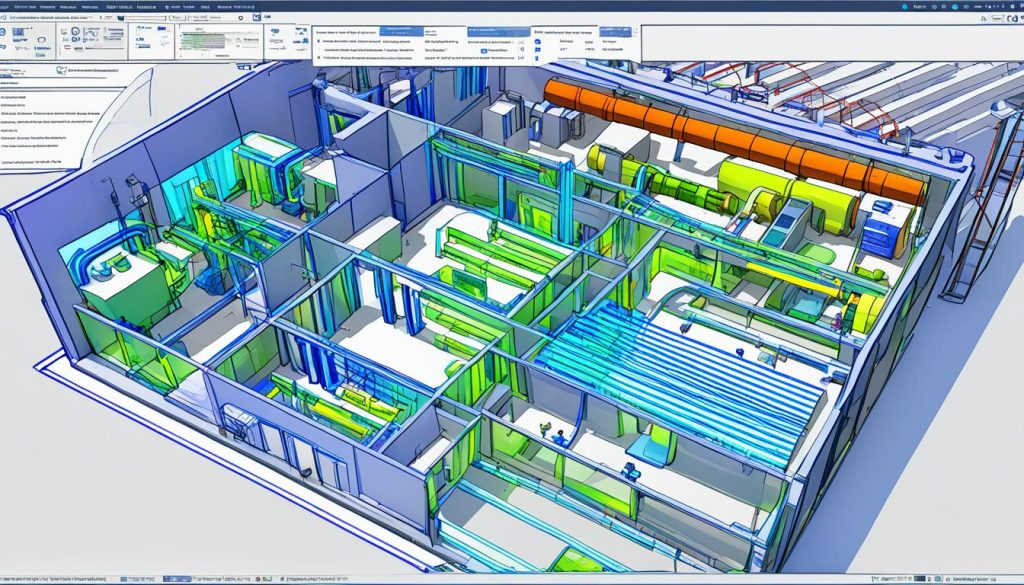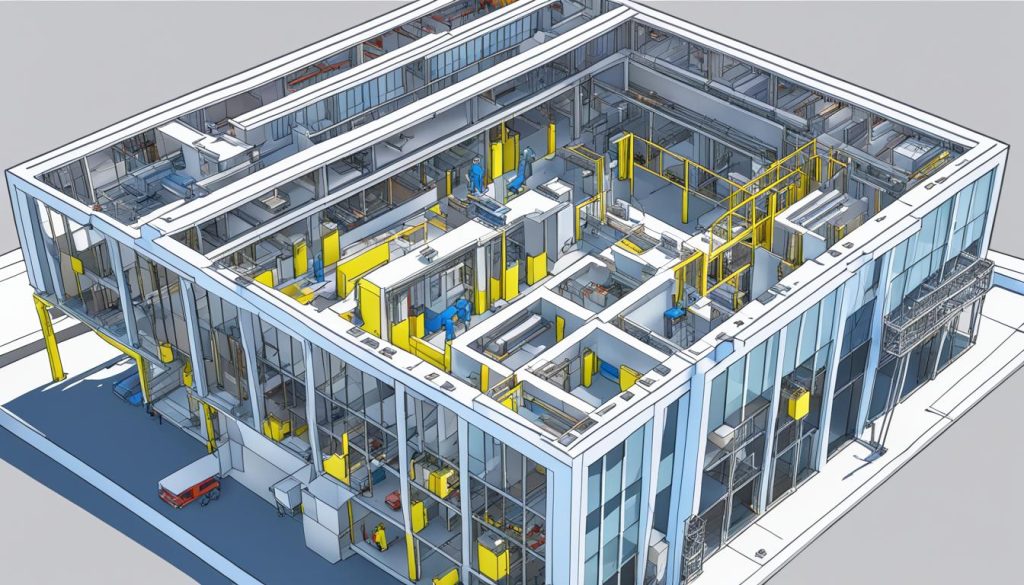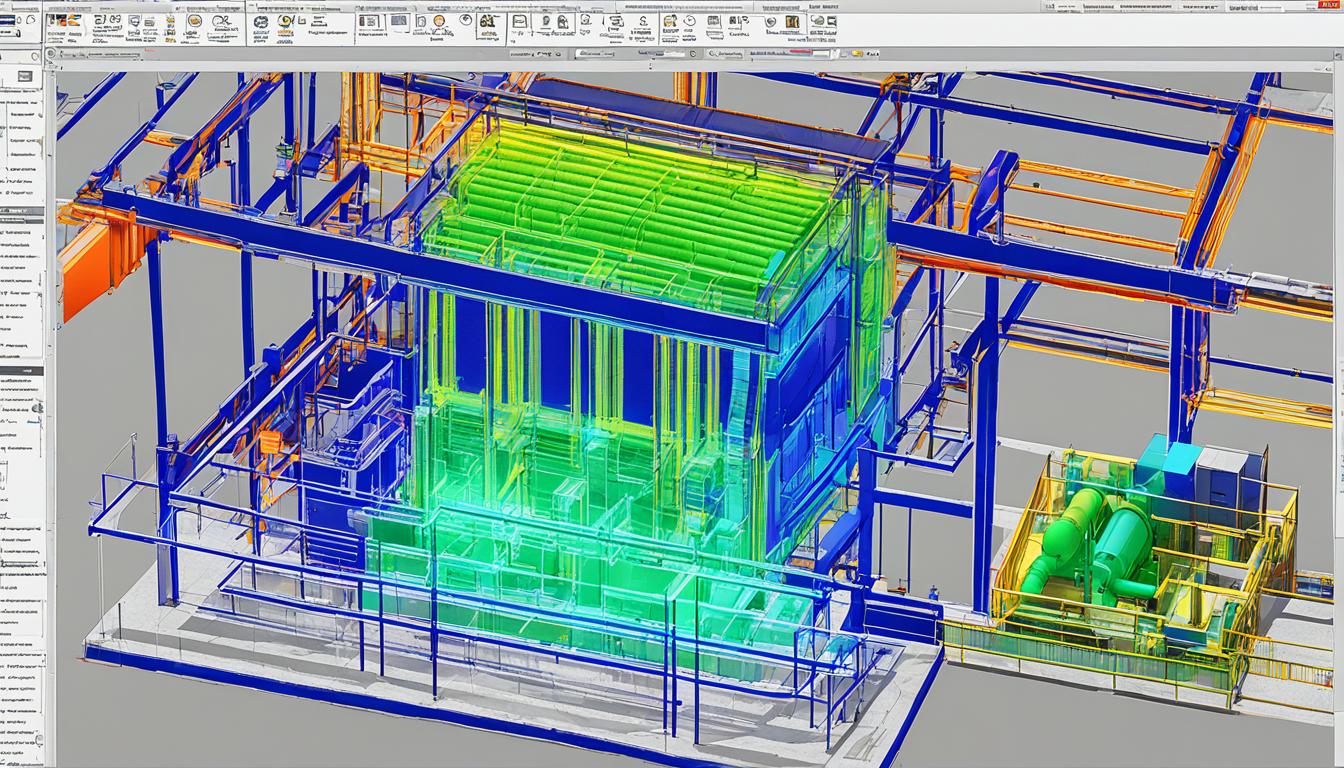Planning HVAC renovations is easier with CAD software and 3D laser scanning. These tools help you make precise designs and get accurate measurements of current systems. This makes your remodeling strategies more effective.
CAD design lets you make detailed digital models of your renovation plans. Adding 3D laser scanning for HVAC gives you a full view of the system’s layout. This helps spot problems and improve your design before starting work.
These technologies make planning HVAC renovations faster, with fewer mistakes, and more efficient. Using them means you’re ready to handle complex projects. This ensures your HVAC upgrades are successful.
Understanding the Importance of HVAC Renovation Planning
Planning your HVAC renovation is key to a successful upgrade. Digital tools have changed how experts handle these projects. They bring precision and efficiency that old methods can’t match.
The role of modern technology in HVAC upgrades
Modern tech is vital for HVAC upgrades. Software and 3D modeling let engineers make detailed digital models. These models help spot problems before starting the actual work.
Benefits of precise planning for HVAC renovations
Planning HVAC renovations with precision has many benefits:
- Less mistakes and redo work
- More energy efficiency
- More accurate cost estimates
- Quicker installation
- Improved system performance
Using digital tools for HVAC planning helps improve your project’s results and reduces downtime during upgrades.
Challenges in traditional HVAC renovation methods
Old ways of renovating HVAC systems have their problems:
| Challenge | Impact | Digital Solution |
|---|---|---|
| Manual measurements | Inaccuracies leading to fitting issues | 3D laser scanning for precise dimensions |
| 2D sketches | Limited visualization of complex systems | 3D modeling for comprehensive system views |
| Paper-based plans | Difficulty in sharing and updating information | Cloud-based collaboration platforms |
| Limited data analysis | Suboptimal system design | Advanced simulation software for performance analysis |
By using modern HVAC solutions, you can avoid these issues for a smoother renovation.
Introduction to CAD Software for HVAC Design
CAD software has changed the game for HVAC design. It offers tools for making precise and efficient layouts. If you’re into HVAC renovations, knowing how to use CAD for HVAC is key. These tools help you plan complex systems with great accuracy.
HVAC design software makes the whole process smoother, from start to finish. You can bring in 3D laser scan data easily, making sure your designs fit the building perfectly. This cuts down on mistakes and errors that old methods often have.
With CAD tools, you can:
- Create detailed 3D models of HVAC systems
- Simulate airflow and temperature distribution
- Detect potential clashes with other building elements
- Generate accurate bills of materials
- Collaborate effectively with team members
Using CAD for HVAC layouts helps you make your systems work better, use less energy, and follow building codes. The software’s precision means you can use space better and place equipment just right. This leads to a more efficient system overall.
When looking at HVAC design software, think about how easy it is to use, if it works with other tools, and its HVAC-specific features. Spending time to learn these tools will make you better at planning and doing HVAC renovations.
The Power of 3D Laser Scanning in HVAC Projects
3D laser scanning changes HVAC projects by making precise digital copies of buildings. This new method makes HVAC planning more accurate and efficient. It changes how experts plan and do renovations.
How 3D Laser Scanning Works
3D scanning uses handheld devices to scan whole buildings. It creates detailed 3D models with point clouds. These scans capture surfaces, shapes, and small details, making a full digital model for HVAC planning.
Advantages Over Manual Measurements
3D scanning has big advantages over old methods:
- Higher accuracy in capturing complex shapes
- Faster data collection, cutting down on-site time
- Ability to catch small details missed by manual methods
- Creating detailed digital models for better planning
Applications in HVAC Renovations
3D scanning is used in many HVAC projects:
| Application | Benefit |
|---|---|
| Ductwork Design | Precise fitting in complex spaces |
| Equipment Placement | Optimal positioning for efficiency |
| Retrofit Planning | Accurate integration with existing systems |
| Clash Detection | Early spotting of potential problems |
Using 3D scanning in HVAC modeling leads to better, more precise, and cost-saving renovation plans. This tech helps create HVAC solutions that fit each building perfectly.
Integrating CAD and 3D Laser Scanning for Optimal Results
Using CAD and 3D scanning together is a game-changer for HVAC renovations. It combines point cloud data with 3D models, changing how we model HVAC systems. Now, you can easily check where big ductwork should go and make precise models of buildings and systems.

This tech combo lets you match scan data with CAD drawings. Spotting and fixing issues before starting construction saves time and money. With advanced modeling, you can:
- Find clashes between new and old systems
- Measure tricky spaces accurately
- Make detailed 3D models of buildings
- Plan installations with more precision
Combining CAD and 3D scanning helps you see the whole HVAC system in the building. This lets you make smart choices about where to put equipment, how to route ducts, and how to optimize the system. This leads to a smoother design process and better project results.
| Traditional Methods | CAD and 3D Scanning Integration |
|---|---|
| Manual measurements | Automated point cloud data collection |
| 2D drawings | 3D models with accurate spatial information |
| Limited visualization | Comprehensive system visualization |
| Higher risk of errors | Reduced discrepancies and clashes |
By using these cutting-edge HVAC modeling methods, you lead the industry. CAD and 3D scanning improve accuracy and make renovating easier, from planning to doing.
Plan HVAC Renovations Using CAD Software and 3D Laser Scanning
Planning your HVAC renovation needs to be precise and efficient. Using CAD-based planning and 3D laser scanning helps you get the best results. Let’s look at the steps, things to think about, and how to do it right for a great HVAC upgrade.
Step-by-Step Guide to Planning HVAC Renovations
To start your HVAC renovation, follow these steps:
- Conduct initial 3D scans of the existing space
- Process the point cloud data from the scans
- Import the data into CAD software
- Design your HVAC upgrades within the CAD environment
- Verify plans against existing conditions
Key Considerations for CAD and 3D Scanning
When using CAD and 3D scanning for your HVAC renovation:
- Minimize disruptions in active buildings by scheduling scans during off-hours
- Ensure data accuracy through proper calibration of scanning equipment
- Customize deliverables to meet specific client needs and project requirements
Best Practices for Efficient Renovation Planning
Follow these best practices for a smooth HVAC renovation:
- Create a detailed project timeline incorporating scan and design phases
- Use CAD software to simulate airflow and optimize system performance
- Conduct regular team meetings to review progress and address challenges
- Re-scan the space after renovations for future reference and maintenance
By following these guidelines, you’ll make your HVAC renovation process smoother and more accurate. You’ll get efficient results with CAD-based planning and 3D laser scanning technology.
Case Study: Successful HVAC Renovation Using Advanced Technology
A recent HVAC renovation in Toledo, Ohio, shows how advanced technology can change big projects. This 3D scanning project updated the heating and cooling in a 10-story office building.

The team had a big task: update 240,000 square feet without stopping work. They used the latest 3D laser scanning tech to get it done.
Scanning Process
They used Leica RTC360 and P40 scanners to get detailed data of the building. This included:
- Office spaces
- Interstitial systems
- Mechanical rooms
This scanning was done without interrupting the office work. It saved time and money for the owners.
3D Model Benefits
The 3D model was key for designing the system and avoiding clashes. Engineers used it to:
- Find conflicts before building
- Improve the HVAC layout
- Cut down on changes on-site
This careful planning cut down on extra work and made the installation smoother.
| Metric | Traditional Method | 3D Scanning Method |
|---|---|---|
| Time to Survey Building | 4 weeks | 5 days |
| Accuracy of Measurements | ±2 inches | ±2 millimeters |
| Design Revisions Needed | 12 | 3 |
| Project Completion Time | 18 months | 14 months |
This HVAC renovation shows the power of 3D scanning in big projects. Using these tools means better accuracy, efficiency, and saving money in your HVAC updates.
Overcoming Challenges in HVAC Renovation Planning
HVAC renovation challenges can seem tough, but you can beat them with the right plan. Let’s look at common problems and how to get past them smoothly.
Common Obstacles in the Planning Process
Renovating HVAC systems can be tricky, especially when you’re working in buildings that are still used. You might also face issues with old blueprints and coordinating with different workers. These problems can cause delays, go over budget, and disrupt daily life.
Solutions for Smooth Execution
To get past these hurdles, think about using non-invasive scanning to reduce disruption. Make detailed 3D models of the current systems to update old plans. Sharing digital files with everyone on the project can also help improve teamwork.
Leveraging Technology for Risk Mitigation
Technology is key in avoiding risks in HVAC projects. New software gives accurate measurements and spots potential problems with building systems. It also helps everyone work together better. This way, you can avoid big mistakes and save time and money.
| Challenge | Solution | Technology Used |
|---|---|---|
| Outdated blueprints | 3D modeling | Laser scanning |
| Coordination issues | Digital file sharing | Cloud-based platforms |
| System clashes | Clash detection | BIM software |
By using these solutions and technology, you can beat HVAC renovation challenges. Remember, good planning and the right tools are essential. They help you avoid risks and reach your goals.
Future Trends in HVAC Renovation Technology
The future of HVAC renovations is exciting, with new technologies set to change the game. You’ll see more efficient and smart systems that adjust to your needs. Let’s dive into the latest developments that will shape HVAC renovations.
Advanced 3D scanning devices are getting more precise and easy to use. They will help you get detailed info about your current HVAC setup. This makes renovations more accurate. Also, combining 3D scanning with Building Information Modeling (BIM) software is a big deal. It gives you a full view of your building’s systems, making planning and doing the work easier.
Artificial Intelligence (AI) will be a big part of HVAC renovations soon. AI systems will predict when maintenance is needed, use energy better, and suggest ways to improve based on your building’s specifics. Your renovated HVAC system will be smarter and use energy more efficiently than ever.
| HVAC Technology Trend | Impact on Renovations | Benefits for Building Owners |
|---|---|---|
| Advanced 3D Scanning | More accurate planning and design | Reduced errors and rework |
| BIM Integration | Comprehensive system visualization | Better coordination and fewer conflicts |
| AI-Powered Systems | Predictive maintenance and optimization | Lower energy costs and improved comfort |
The future of HVAC renovations also means more focus on being green. You’ll see more eco-friendly refrigerants, systems that recover energy, and smart thermostats that learn your habits. These changes will make your building more comfy and cut down on harm to the environment.
Cost-Benefit Analysis of Using CAD and 3D Scanning for HVAC Renovations
Looking at HVAC renovation costs, it’s key to compare the upfront costs with long-term savings. CAD software and 3D scanning might seem pricey at first. But, they often save money over time.
Initial Investment vs. Long-Term Savings
The cost to start with CAD and 3D scanning is high. You’ll need to buy software, hardware, and train your team. But, these tools can save a lot of money later by cutting down on mistakes and making renovations smoother.
Improved Accuracy and Reduced Rework
Using advanced tech in HVAC renovations means better accuracy. 3D scanning gives exact measurements of what’s already there. This means fewer changes needed on-site, less mistakes, and less rework. It saves time and money.
Enhanced Project Efficiency and Timelines
The benefits of 3D scanning in HVAC projects are clear when you look at how efficient it makes things. With detailed 3D models, planning renovations is easier, you can spot problems ahead of time, and finish projects quicker. This leads to big cost savings and happier clients.





0 Comments